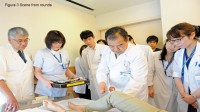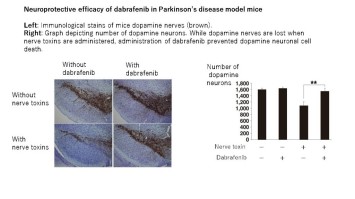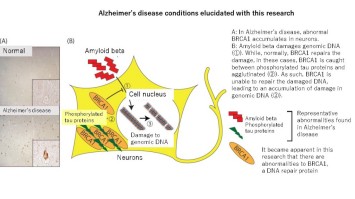Top > About Us > News Letter > Neurology Department
Aiming to elucidate pathological conditions and develop treatments for neurological diseases through cross-sectoral approaches
From The University of Tokyo Hospital to the World
Neurology Department
Tatsushi Toda, Professor and Chairman

In our clinical practice, which aims to contribute to clinical neurology through elucidating pathological conditions, developing treatments, and conducting clinical trials for a wide range of neurological diseases, we combine clinical practice targeting junior residency and clinical practice incorporating highly advanced medicine. In our outpatient practice, we ensure enough time is spent on each patient and have established separate specialized outpatient clinics for patients with Parkinson’s disease, dementia, and multiple system atrophy to provide a more well-rounded practice. Clinical practice for inpatient wards focuses on incorporating advanced medicine with programs for postgraduate training (junior residency, senior residency) in place. Our facility also conducts investigator-initiated trials based on research results proving COQ2 genetic mutations are involved in onset of familial/sporadic multiple system atrophy.
Our facility’s goal is to conduct multiple research targeting diseases in each field including molecular genetics, molecular biology, embryonic engineering, biochemistry, pharmacology, cellular biology, pathology, and physiology, and implement a cross-sectoral, integrated approach. We would like to provide a brief overview on our department’s research successes, focusing primarily on recent findings.
In terms of an approach for molecular targeted therapy, we identified tandem ribitol-phosphate sugar chains using sugar chemistry methodologies for elucidating molecular pathological conditions and treatments for dystroglycanopathy. We also discovered that causative genes of Fukuyama congenital muscular dystrophy and limb-girdle muscular dystrophy type 2I, i.e. fukutin and FKRP, were ribitol-phosphate transferases that sequentially incorporate ribitol-phosphate into sugar chains using CDP-ribitol as a donor substrate.
Research is also being conducted for optimization of treatment for sporadic and familial Parkinson’s disease utilizing genomic methods. In terms of identification of new rare variants, we have been conducting exome sequencing to discover rare yet strong Parkinson’s disease (PD) genomic factors within exons. In terms of discovery of new anti-PD drugs using new methodologies based on informatics, we have identified that dabrafenib for malignant melanoma demonstrates suppression in neuronal cell death in vitro (creating an artificial environment mimicking in vivo conditions using test tubes, etc., with animal tissue) and MPTP animal models (animal models for Parkinson’s disease) (Figure 1).

Figure 1

Figure 2
We have also been placing efforts on genomics research utilizing next generation sequencing for molecular genetics. For genetic and sporadic neurological diseases (e.g. multiple system atrophy, amyotrophic lateral sclerosis, Alzheimer’s disease, etc.), we are trying to identify disease-related genes using patient/control-related analysis based on comprehensive genomic sequencing. Furthermore, we are examining clinical features of hereditary amyotrophic lateral sclerosis (TBK1) by conducting collaborative studies with Center for Genomic Medicine.
In the physiology field, we have been researching pathophysiological mechanisms of motion/sensory physiology and motor dysfunction through use of neurophysiological tests such as magnetic stimulation, electroencephalogram, and magnetoencephalography. We have been involved since the initial development of transcranial magnetic stimulation, which can stimulate brain neurons noninvasively, and we have been able to discover clinical applications using various new magnetic stimulations. Recently, we have been participating in a wide range of advanced research including basic research to develop and identify mechanisms of new repetitive transcranial magnetic stimulation (rTMS) as well as multicenter clinical trials in order to find clinical applications of rTMS and its neuromodulation ability as treatment for basal ganglia disorders including Parkinson’s disease.
The peripheral nerve/muscular pathology research laboratory aims to explore the pathological conditions of inflammatory myopathy by utilizing analysis related to clinical features, myositis autoantibodies, cytokines and chemokines, muscular pathology findings, and mRNA expressed within muscular tissues. The laboratory is also conducting clinical research on changes in muscle function associated with muscular atrophy based on analysis of tissue findings by examining quantitative analysis of muscles in relation with myositis, aging, and disuse through DXA.
The biochemistry laboratory performs brain biopsies for Alzheimer’s disease, Lewy body dementia, multiple system atrophy, and amyotrophic lateral sclerosis, and is promoting neuro-epigenetics research focused on methylation analysis specialized in neurons. For Alzheimer’s disease, the laboratory identified functional abnormalities of BRCA1, a DNA repair protein, using Epigenetics DNA methylation research, and reported the importance of DNA damage accumulation on disease conditions (Figure 2). In order to prove the identified disease hypothesis, the laboratory has established a human Alzheimer’s disease model using progenitor cells and is currently validating the disease model. Furthermore, in addition to methylation analysis, they have adopted a new approach to explore molecular disease conditions through histone modification analysis, an important expression regulation factor.
Neuroimmunological research is focused on elucidating inflammatory diseases of the central nervous system including multiple sclerosis and neuromyelitis optica. Immunological microenvironments, which may greatly vary depending on disease state, are studied by molecular biology methods and cellular biology function analysis utilizing cerebrospinal fluid/blood specimens, and biopsied tissues. Cross-sectional analyses are conducted against the detailed first hand clinical information and their significance verified by immunological approaches.
In such a manner, questions encountered at the bedside are addressed at the bench (i.e. from bedside to bench), and successes at the bench are realized as treatments for the bedside (i.e. from bench to bedside); and our facility is dedicated to promoting cutting-edge research aimed at elucidating and overcoming neurological diseases. We have reflected this success onto our clinical practice and continue to place efforts in providing highly advanced medicine.
